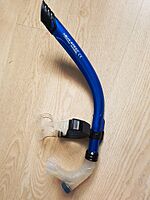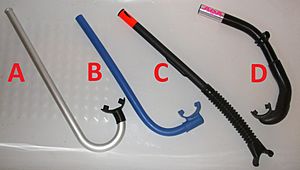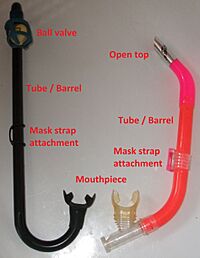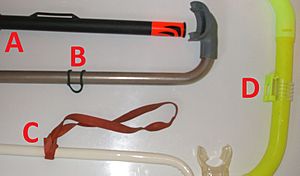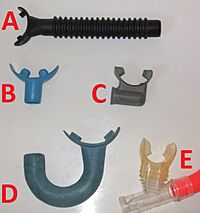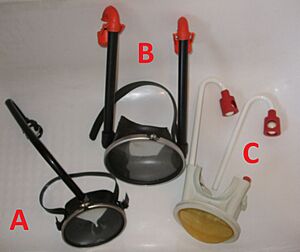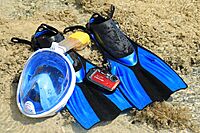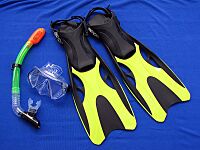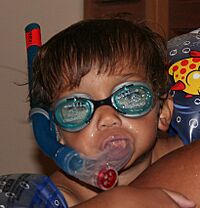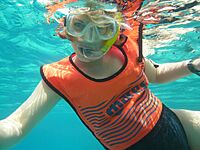Snorkel (swimming) facts for kids
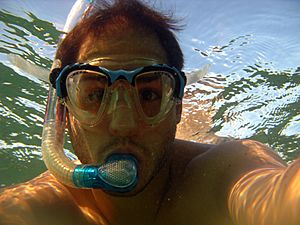
Snorkel, worn with diving half mask
|
|
| Uses | Breathing while face down at the surface of the water |
|---|---|
| Related items | Diving mask, Swimming goggles |
A snorkel is a device people use for breathing atmospheric air when their face is in the water. Sometimes people wear a snorkel with a diving mask when they plan to stay on the surface of the water. A standard snorkel is a curved tube that is usually in the shape of the letter "L" or "J." It has a mouthpiece at the lower end and made from plastic, synthetic elastomers, rubber, or light metal. The snorkel may have a loop or a clip to attach it to the head strap of the diving mask or swimming goggles or may be tucked between the mask strap and the head. Some snorkels also have a float valve to keep water from getting into the tube if the swimmer's head sinks too far underwater. Some have a water trap and purge valve that drains water from the tube.
Swimmers may have difficulty breathing after using a snorkel for a long time because some of the carbon dioxide (CO2) they breathe out stays in the tube, and they inhale it with their next breath. This can cause hypercapnia, a buildup of CO2 in the blood.
Contents
Function
A snorkel is used to allow the user breathe atmospheric air while they swim or float on the surface of the water with their face underwater. A snorkel that works correctly has a large enough tube to allow the user to inhale and exhale comfortably.
Snorkel tubes are a specific length because longer tubes would make breathing much more difficult when swimmers snorkel in deeper water. The muscles that expand the lungs would have to work harder because of the increase in water pressure around the swimmer.
Types
The basic snorkel types are not attached to a diving mask. They are usually in the shape of the letter "L" or "J" and can be called several names: "simple," "plain," "tube," "pipe," "independent snorkels," or just "snorkels." They have curved tubes with a mouthpiece that the snorkeler bites. The tube is an open tube that can flood when it goes all the way underwater. Some tubes are topped with a valve to prevent water from entering the tube when it is submerged.
Some snorkels have a sump at the lowest point to prevent a small volume of water remaining in the snorkel from being inhaled when the snorkeler breathes.
"Integrated" snorkels are part of a snorkel mask. Masks can be a half-mask that covers the eyes and nose or a full-face mask that covers the eyes, nose, and mouth.
Operation
Snorkelers wear snorkels in their mouth, making sure the top of the tube is above the surface of the water. They can then freely breathe air. If the top of the tube goes underwater, snorkelers can clear any water that goes into the tube. They do this by making sure the top of the tube is above water and blast clearing: exhaling sharply to shoot out the water. Another way to clear water from the tube is displacement clearing: tilting the head back shortly before reaching the surface and exhaling until they reach the surface, then facing downward before taking the next breath. This only works when surfacing after being underwater.
Risks
Human
When snorkelers breathe, they inhale oxygen from the air and exhale carbon dioxide (CO2). Because a snorkel is a tube, some of the CO2 stays in the tube and is inhaled on the next breath. This increases the risk of hypercapnia, a buildup of carbon dioxide in the blood. A smaller diameter tube reduces the amount of CO2 left for the next breath, but also increases resistance to airflow and therefore makes breathing harder.
There is also a danger that a snorkeler who can breathe comfortably in good conditions will be unable to breathe well under stress or when working harder, leading to hypercapnia and possible panic.
Material
Modern snorkels use silicone rubber in the mouthpiece and valves because it does not degrade like natural rubber. Natural rubber was formerly used, but slowly oxidizes and breaks down due to ultraviolet (UV) exposure from the sun. It eventually loses its flexibility, becomes brittle and cracks, which can cause valves to stick or leak and mouthpieces to leak. Natural rubber can also cause an allergic reaction in some people.
Applications
Snorkels can be used in snorkeling, finswimming, freediving, and scuba diving. During scuba diving, snorkels are useless. They are used to save the air in the tank when the diver is going to swim on the surface for a long time. A scuba diver may carry a collapsible snorkel in a pocket to keep it safely out of the way when not in use during a dive.
History
Breathing surface air through a tube was mentioned by Aristotle in his Parts of Animals. He referred to divers using "instruments for respiration" resembling the elephant's trunk. Some evidence suggests that sponge divers used hollowed-out reeds 5,000 years ago in Crete. In the fifteenth century, Leonardo da Vinci drew designs for an underwater breathing device.
The first documented use of a swimmer's breathing tube and mask was in 1927. Jacques O'Marchal exhibited them in 1931 at the International Nautical Show. He also wore the first "flippers," designed by Louis de Corlieu. Throughout the 1930s, inventors tried to improve the snorkel's design.
The word "snorkel" was first used in 1950 to refer to a breathing device for swimmers. In 1969, Britain became the first country to establish national standards, or rules, for snorkels. This British standard sets different maximum and minimum snorkel dimensions for adult and child users. It also says what materials and designs are allowed. Each snorkel must have a warning label and a set of instructions in the package. Other countries now have rules about how long tubes can be and what the diameter of the tubes can be for both child and adult swimmers.
Orientation and shape
Snorkels are made for two orientations: Front-mounted and side-mounted. The first snorkel to be patented in 1938 was front-mounted. It was worn with the tube over the front of the face and secured with a bracket to the diving mask.
Side-mounted snorkels are generally worn by scuba divers on the left-hand side of the head because the scuba regulator hose is routed over the right shoulder. They come in at least four basic shapes: J-shaped, L-shaped, flexible-hose, and contour. The picture to the right shows what each looks like.
- A. J-shaped
- B. L-shaped
- C. Flexible-hose
- D. Contour
Basic snorkel construction
A basic, or independent, snorkel is a curved tube with a mouthpiece to be inserted between the lips and gripped by the teeth.
The barrel is the hollow tube leading from the top of the snorkel to the bottom, where the mouthpiece is attached. The barrel is made of hard material such as plastic, light metal, or hard rubber. The top of the barrel may be open, or it may have a valve that plugs when the top goes underwater. There may be a red or orange band around the top of the barrel so other swimmers can see the snorkel.
There are several ways to attach the snorkel to the swimmer. The simplest way is to place the barrel between the mask strap and the head. Other ways can be seen in the picture to the right:
- A. The mask strap is threaded through the loop molded onto the barrel.
- B. The mask strap is threaded through the separable rubber loop or plastic clip slid over the barrel and held in place by friction.
- C. The rubber band knotted to this 1950s American snorkel barrel is stretched over the head above the mask.
- D. The mask strap is threaded through the rotatable plastic snorkel keeper positioned about halfway up the barrel.
The mouthpiece is what keeps the snorkel in the mouth. It is made of soft and flexible material like PVC. The picture on the right shows some mouthpieces.
Integrated snorkel construction
Integrated snorkels are snorkels with one or two tubes that are part if a swim or dive mask. They can be part of half-mask or full-face snorkel masks (FFSM). The picture to the right shows some integrated snorkels.
- A. This integrated snorkel is a half-mask that covers only the eyes and nose. A permanent single snorkel comes from the top of the mask and ends with a ball float shut-off valve.
- B. This full-face snorkel mask (FFSM) has a chinpiece to cover the eyes, the nose, and the mouth. Permanent twin snorkels come from either side of the mask and end above with "gamma" shut-off valves.
- C. This model is a half-mask that covers only the eyes and nose. The twin snorkels come from either side of the mask and can be removed. They end with ball float shut-off valves. This model comes with plugs that swimmers can use when the snorkels are not attached.
Associated equipment
Vision aids
If a separate snorkel is used, the user will usually wear a diving half-mask or swimming goggles to improve underwater vision. By creating an airspace in front of the eyes, the mask allows the snorkeler to see clearly underwater.
Swimming aids
The most common swimming aids used by snorkelers are swimfins. A snorkeling vest may be used for buoyancy.
Environmental protection
Many snorkelers wear wetsuits or dry suits for protection against cold water and ultraviolet (UV) in sunlight. A wetsuit is most popular for keeping swimmers and divers warm. Wetsuits, diving skins, and rash vests provide UV protection. Some divers are beginning to wear dry suits like the ones used during the 1950s and 1960s. They are usually used in lakes and rivers.
Interesting facts about the snorkel
- Aristotle is credited with the first idea of a snorkel when he wrote about an elephant using its trunk to breathe underwater in 350 B.C.
- The word “snorkel” comes from the German term “Schnorchel,” meaning "snout."
- The first patented snorkel was front-mounted and worn over the face, but side-mounted snorkels became more popular in the late 1950s.
- Front-mounted snorkels have since made a comeback in competitive swimming, where they are more streamlined than side-mounted snorkels.
- Some older snorkels had small balls in a cage at the top of the tube to prevent water from entering, but these are no longer recommended because they can be hazardous and are illegal in some countries.
- Snorkels are not used during scuba diving unless the diver is going to swim at the surface of the water for a long time.
- Because snorkels allow swimmers to breathe while their face is in the water, swimmers should look around outside the water occasionally to be sure they are not swimming too far from shore or a boat.
- A snorkel can last 2-15 years, depending upon how much it is used and how well the owner takes care of it.
- Using a snorkel can be relaxing, allowing a swimmer to glide slowly along the water's surface.




